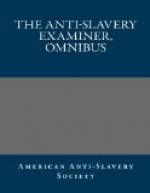6. That slaves are branded with hot irons, and very much scarred with the whip.
7. That iron collars, with projecting prongs, rendering it almost impossible for the wearer to lie down, are fastened upon the necks of women.
8. That the LASH is the MAIN SUPPORT of the slaveholder’s authority: but, that the stocks are “a powerful auxiliary” to his government.
9. That runaway slaves are chased with dogs—men hunted like beasts of prey.
Such is American Slavery in practice.
The testimony thus far adduced is only that of the slaveholder and wrong-doer himself: the admission of men who have a direct interest in keeping out of sight the horrors of their system. It is besides no voluntary admission. Having “framed iniquity by law,” it is out of their power to hide it. For the recovery of their runaway property, they are compelled to advertise in the public journals, and that it may be identified, they are under the necessity of describing the marks of the whip on the backs of women, the iron collars about the neck—the gun-shot wounds, and the traces of the branding-iron. Such testimony must, in the nature of things, be partial and incomplete. But for a full revelation of the secrets of the prison-house, we must look to the slave himself. The Inquisitors of Goa and Madrid never disclosed the peculiar atrocities of their “hall of horrors.” It was the escaping heretic, with his swollen and disjointed limbs, and bearing about him the scars of rack and fire, who exposed them to the gaze and abhorrence of Christendom.
The following pages contain the simple and unvarnished story of an AMERICAN SLAVE,—of one, whose situation, in the first place, as a favorite servant in an aristocratic family in Virginia; and afterwards as the sole and confidential driver on a large plantation in Alabama, afforded him rare and peculiar advantages for accurate observation of the practical workings of the system. His intelligence, evident candor, and grateful remembrance of those kindnesses, which in a land of Slavery, made his cup of suffering less bitter; the perfect accordance of his statements, (made at different times, and to different individuals),[B] one with another, as well as those statements themselves, all afford strong confirmation of the truth and accuracy of his story. There seems to have been no effort, on his part to make his picture of Slavery one of entire darkness—he details every thing of a mitigating character which fell under his observation; and even the cruel deception of his master has not rendered him unmindful of his early kindness.
[Footnote B: The reader is referred to JOHN G. WHITTIER, of Philadelphia, or to the following gentlemen, who have heard the whole, or a part of his story, from his own lips: Emmor Kimber, of Kimberton, Pa., Lindley Coates, of Lancaster Co., do.; James Mott, of Philadelphia, Lewis Tappan, Elizur Wright Jun., Rev. Dr. Follen, and James G. Birney, of New York. The latter gentleman, who was a few years ago, a citizen of Alabama, assures us that the statements made to him by James Williams, were such as he had every reason to believe, from his own knowledge of slavery in that State.]




